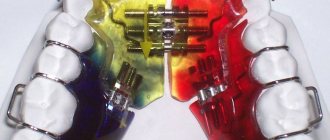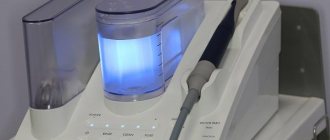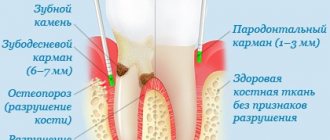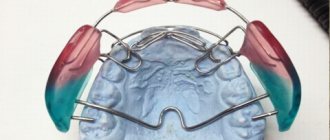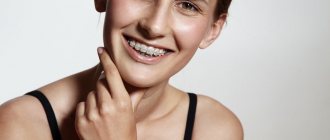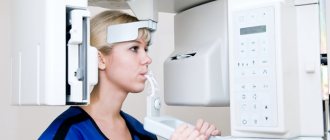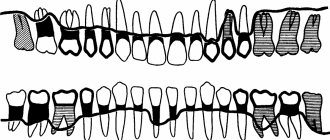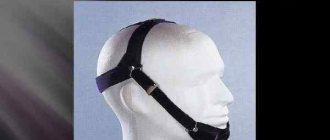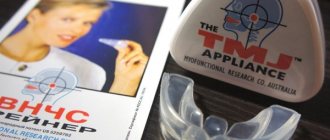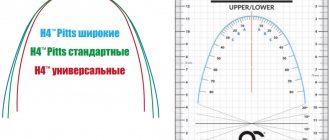The narrowing of the upper jaw causes the development of a wide variety of malocclusions in a child. For example, when shortening the arch, there is simply not enough space for the canines and incisors. And this leads to overlap of individual units, development of speech and chewing defects. Using the device allows for correction, eliminating wear, especially of baby teeth, and the development of physiological problems.
The device was developed by dentist Ross; it is an expander that is installed at an early stage of pathology development, when defects can be easily corrected. Structurally, it is a non-removable plate device supported on molars or fangs. Supports are divided into mutual, reciprocal, reactive, and active. The basis of the design depends on the characteristics of the treatment:
- acrylic in the form of a two-part plate that transfers loads to the supporting units using a reinforcing screw;
- guides with Hyrex screws for creating expansion using a power element;
- support rings for molars in children;
- metal rods to transfer force to the fangs in children.
The expansion of the device reaches a maximum of 13 millimeters. At the same time, the device lengthens the row, the space for cutting increases. This returns the face to normal symmetry, which is especially important for children under the age of 6-8 years.
Design of the Marco Rosa apparatus and the Haas apparatus
The Marco Rosa apparatus (its creator is Dr. Marco Rosa) is very similar to the Haas apparatus and is a non-removable intraoral plate apparatus, made individually from dental casts. The device is secured with rings to the chewing teeth and has additional support on the fangs. In the central part of the plate there is a screw for expanding the upper jaw.
The Marco Rosa apparatus and the Haas apparatus are used to expand the maxilla. The advantage of these devices for maxillary expansion is that you cannot forget to put them on or lose them. The devices operate around the clock, which improves the quality of treatment and reduces the time of orthodontic treatment.
When developing the design of the device, the child can choose the color of the plastic parts, add decorations to them - pictures, sparkles, etc. This increases motivation and helps eliminate anxiety about the upcoming treatment.
Installation process
The plate is attached to the supporting teeth using two rings, put on the molars, and two rods, which are glued to the canines with a composite.
The installation procedure includes preparatory and basic operations.
Preparatory
- Installation of elastomer separation rings in the proximal space of the support painters to create a gap under the support rings. Separation elements are installed approximately a week before fixing the expander.
- Brushing your teeth with a rotary brush immediately before installing the device.
Basic Operations
- After cleaning and drying the teeth, cement is applied to the inner surface of the rings. The rings are put on the molars and pressed with the tool until it stops. Excess cement is removed with a scaler or other tool.
- A composite is applied to the area of contact between the “paws” and the fangs. After its distribution over the contact area and removal of excess, the composite is irradiated with light for polymerization.
When to use the Marco Rosa apparatus and the Haas apparatus
The Marco Rosa apparatus, like the Haas apparatus, is used to expand the upper jaw in children aged 6-9 years during the period of occlusion change.
The use of the Marco Ross apparatus or the Haas apparatus allows us to solve the following problems:
- lack of space for permanent teeth – growth of teeth in the second row, crooked teeth;
- crossbite;
- advancement of the lower jaw;
- speech therapy problems;
- violation of nasal breathing associated with the narrowness of the nasal passages.
Causes of narrowing of the upper jaw
- genetic reasons;
- mouth breathing due to insufficient patency of the nasal airways (adenoids, polyps, allergic edema);
- a constantly open mouth (not associated with mouth breathing) due to improper functioning of the facial muscles.
Reviews
Refusal of treatment with the Marco Ross device under the pretext that it is better to eliminate the anomaly later with the help of braces is a serious mistake. The earlier the bite correction begins, the faster and easier it is.
If your child had to wear a Ross apparatus, tell us how successful and quick the treatment was. Did you have to use braces after that? The feedback form is at the bottom of this page.
If you find an error, please select a piece of text and press Ctrl+Enter.
Tags devices: bite correction
Did you like the article? stay tuned
No comments yet
How the Marco Rosa appliance and the Haas appliance work for maxillary expansion
After consultation and diagnosis, the orthodontist makes calculations and transfers dental impressions to the dental laboratory. The production time for the device is about 10 days. The orthodontist fixes the fixed appliance with special glue onto previously cleaned teeth. Activation of the screw (turning the screw with a key) causes expansion of the palatal suture and a gradual increase in the size of the upper jaw.
Getting used to the Marco Rosa apparatus (Haas apparatus) takes several days (diction is slightly impaired). The plate does not put pressure on the palate, but only lightly touches it. From the outside, the Rosa apparatus is practically invisible.
Activation of the screw to expand the upper jaw is carried out by parents at home, at the same time every day, according to a scheme developed by the orthodontist. The expansion of the upper jaw lasts about 3-4 weeks. Then the device remains on the child’s teeth for another 7-8 months to stabilize the achieved result.
During treatment with a fixed apparatus for expanding the upper jaw, no special hygiene is required; it is enough to brush your teeth twice a day and use an irrigator.
When the upper jaw expands, the nasal passages expand, which is important for patients with impaired nasal breathing.
The Marco Rosa apparatus expands the upper jaw, but since the growth of the jaws is interconnected, the lower jaw is also affected, it adapts to the changes that occur.
When wearing plates, you must follow some rules
- Brush your teeth at least twice a day and be sure to rinse your mouth after every meal - this will avoid the accumulation of microbes on their surfaces and the occurrence of dental caries.
- Remove during meals and active sports in order to avoid unnecessary contamination of the plates, food getting stuck in them, their breakage and dental trauma.
- It is necessary to clean the records daily, with a toothbrush and a special gel.
- Make sure that no hard deposits form on the record. If plaque appears that cannot be cleaned on your own, you should contact the clinic for professional cleaning of the records.
- For disinfection, it is necessary to leave it in a special solution once a week, at night.
Examples of treatment with the Marco Rosa apparatus from the practice of orthodontists “Dial-Dent”
Example 1
Girl 7 years old. Open bite, narrowing of the upper jaw, constantly breathes through the mouth.
With the help of the Marco Rosa apparatus, the expansion of the upper jaw to the required size was achieved, and nasal breathing was normalized. Orthodontist M.P. Sleptsova, assistant orthodontist L. Rodina.
Example 2
Boy 8 years old. Narrowing of the upper jaw, advancement of the lower jaw. The beginning of the development of class 3 malocclusion (in adults with class 3 malocclusion, more complex and lengthy treatment is required).
As a result of the treatment, the upper jaw was expanded, and correct closure of the teeth in the anterior region was achieved. Orthodontist M.P. Sleptsova, assistant orthodontist L. Rodina.
Example 3
Boy 8 years old. Deep incisal overjet, not enough space for permanent teeth (second incisors).
After treatment with the Marco Rosa apparatus, the size of the jaws was normalized, and enough space was created for the eruption of permanent second incisors. Orthodontist M.P. Sleptsova, assistant orthodontist L. Rodina.
Anomaly classification
Normally, the mandibular arch should be in the shape of a parabola, and the upper one should be an ellipse. However, according to the clinical manifestations, 4 forms of anomaly are observed, characterized by their own specific signs:
- Compression of the dentition (jaw) along its entire length. The defect is characterized by protrusion of the anterior section relative to the entire frontal region. In addition, the elements are arranged in a fan-shape, and the lateral incisors are placed close to the center.
- Narrowing of the anterior sector only. This anomaly is distinguished by the V-shaped appearance of this section of the row, in which the incisors, moving forward, are closely spaced and form a pointed angle.
- Uneven development . It is distinguished by the asymmetry of the dental radius, when its narrowing occurs only in individual segments. It differs from other forms of anomaly in the appearance of crowding of teeth exclusively in a certain area.
- Clenched jaw. A distinctive sign of pathology is compression of the dentition in the area of the molars/premolars, as well as a saddle-shaped jaw.
The pathological condition in this clinical situation is uneven and does not cover other parts of the jaw arch. This form of the defect is characterized by the wrong direction of growth and development of the lateral elements, which over time tilt towards the cheeks or tongue. - Trapezoidal dentition . The jaw arch resembles a trapezoid - flattened, with four corners. The incisors do not come forward, but are crowded. They are often observed to turn around their axis.
Important! Regardless of the form of the defect, over time its clinical picture only worsens, leading to aggravation of the condition and to an even stronger deviation in the position of the elements and compression of the jaw arches.
Many dentists consider parallel narrowing of the jaw arches as a separate (independent) pathology. Distortion of parameters is also diagnosed in cross bite, open deep bite, as well as with progenia or prognathia.
With such developmental anomalies, compression is regarded as a symptom that aggravates the underlying pathology of occlusion.
Will I need braces later?
Orthodontic treatment in children using a fixed Marco Ross appliance helps to normalize the size of the upper jaw, which prevents negative changes in the facial skeleton (protrusion of the lower jaw or its retraction, severe narrowing of the upper jaw), which change the harmony of the face. If the problem of underdevelopment or narrowing of the upper jaw is left unresolved in childhood, surgical expansion of the upper jaw may be required in adulthood.
You may need treatment with braces or mouth guards in the future, but this treatment will be faster and more effective. Quite often, additional wearing of braces after orthodontic treatment with a fixed Marco Rosa appliance is not required.
Analogs
The use of devices for jaw expansion is considered a conservative, gentle option, and therefore can be used to correct both permanent and mixed dentition .
The expansion of a row of teeth is carried out due to low impact forces, which allows this method to be used to treat not only adults, but even small children.
Narrowing of the dentition is a fairly common anomaly, which is characterized by various clinical manifestations. The variability of its development required specialists to use various devices.
Thanks to this, specific methods have been developed for each indication, differing in their mechanism of action. Quite often several methods are combined.
According to reviews, the combined use of braces and the Derichsweiler apparatus can maximize the effectiveness of therapy, and the use of sapphire models, such as Damon Clear, makes the process comfortable and invisible to others.
Derichsweiler apparatus
The Derichsweiler apparatus is a device consisting of support rings and corrective arcs connecting them. The support rings are fixed to the molars and have a soldered lock in which the arches are secured.
The arches converge in the area of the palatal arch, where the activator is located - a screw that transmits a certain constant pressure during rotation. Under its influence, the palatal suture opens, causing the jaw to expand.
The gap formed when the palate opens is filled with new bone tissue after some time.
The main indication for the use of this device is the narrowing of the jaw arch during the early mixed dentition period. When treating anomalies in permanent occlusion, the device gives minimal results, since it cannot cope with the ossified palatal suture.
The device has certain advantages :
- it has a gentle effect during correction, so it does not cause discomfort while wearing;
- the impossibility of removing the device allows you to restore the normal state of the jaw in a short period of time;
- the design does not damage the periodontium and soft tissues of the palate.
However, in addition to the advantages, this device also has disadvantages :
- in the first days of wearing, increased salivation and disturbances in the pronunciation of sounds may be observed;
- in some cases, injury to the surface of the tongue is noted;
- impossibility of self-correction. To implement this, frequent visits to the dentist are necessary;
- When worn, normal cleaning of the oral cavity becomes difficult.
Palatal expander
This device is designed to expand the dentition of the upper jaw only , during the period of mixed and permanent dentition.
The classic device consists of support rings that are installed on the posterior teeth. As a rule, one pair is installed on the premolars, and the other on the penultimate molars.
Power arcs are soldered to the support rings, which are arranged crosswise in relation to each other. In the center of the device, in the middle area of the palatine vault, there is a special screw. It is designed to activate the device and provide constant pressure on the sides of the jaw.
The palatal expander has certain advantages :
- has a pronounced force effect, due to which expansion occurs in a short period of time.
Correction for mixed dentition can take only about 1 month. To eliminate anomalies in the permanent bite, this period is 3 months; - has the ability to move teeth corpusally; during correction, the jaw arch expands, but the roots remain in their sockets without forming their enlargement;
- possibility of self-activation, which is performed using a special key. The structure is activated once every 2 days.
The disadvantages of a palatal expander are:
- constant injury to the tongue and rubbing of the soft tissues of the palate;
- to obtain rapid expansion, activation of at least 1 mm is required.
In comparison, on other devices the correction only requires activation by 0.25 mm. This forcing leads to constant pain during the treatment period; - the device requires the use of additional cleansing agents and a certain diet, with the exclusion of viscous and acidic foods in the diet.
Springs
With the main devices for expanding the jaw arch, additional elements - springs - are often used. They allow you to enhance the impact effect and significantly reduce the correction period .
For these purposes, several types of springs :
- Coffina .
Used for sectoral expansion of the jaw arch, its lengthening or distal-mesial movement. The spring is a round, pear-shaped or oval curve with two branches for fixation on the main apparatus. The spring can be either single or double. For its manufacture, metal wire with a cross-section from 0.7 to 1.5 mm is used. - Pin-shaped . Used to eliminate narrowing of the entire upper jaw. Made from wire of the same size as the Coffin spring. It is shaped like a safety pin. The length of this product significantly exceeds the first option.
- Kollera . Used to change the width of the lower row of teeth. Depending on the design features, it can be used for both uniform and sectoral correction.
For uniform expansion, a spring is often used, made in the form of a hyoid-type clasp, with two or more semicircular bends and extensions for fixation. For sectoral changes, a spring with only one semicircular bend in the front part is used.
Expansion plate
Unlike a palatal expander, a plate is intended for the correction of mixed dentition with severe dentition anomalies .
How orthodontic plates work, watch the video:
They are used to expand the arch from a very young age. Main age period: 5–10 years .
The peculiarity of this product is that it can be used for uneven narrowing of the dentition. This device is made individually for the patient, based on impressions of his jaws.
It is a removable structure consisting of a base plate and an orthodontic screw. The plate is made of hard plastic and accurately follows the relief of the palatine vault.
It is made taking into account sectoral cuts, which are connected by special springs that increase pressure on the jaw bone. Depending on the type of anomaly, the activator screw can be located either in the center of the plate or in its sectoral part.
In case of localized narrowing of a certain part of the jaw, the screw is installed on the plate on the side of the anomaly.
In order to ensure simultaneous alignment of teeth in the anterior region, the device is equipped with vestibular metal arches.
The main advantages of the device include:
- the complexity of the effect , due to which not only the expansion of the arch is carried out, but also the alignment and flattening of the frontal section;
- accessibility of care - hygienic cleaning takes place without problems, since the device can be removed at any time;
- Painless adaptation period due to minimal impact force.
The disadvantages of this design are as follows:
- Due to the volume of the plate, it is difficult to get used to the device. At first, many people experience a gag reflex;
- It is removable and therefore requires constant monitoring of wearing. If worn infrequently or irregularly, the treatment period may be significantly longer.
Features of the use of the Marco Rosa apparatus in Dial-Dent
Family Dental Orthodontists have a comprehensive approach to correcting malocclusion in children, so the clinic employs an ENT doctor and a speech therapist who help eliminate the causes of malocclusion, thereby increasing the effectiveness and stability of orthodontic treatment.
If there are problems with nasal breathing, ENT doctor A.V. is involved in treatment. Arkhandeev. The participation of an ENT specialist in orthodontic treatment is very important, since without normalization of nasal breathing, the treatment result will not be stable and no device will help!
If there is improper muscle function, incorrect position of the tongue, infantile swallowing, if the mouth is constantly open, even when breathing through the nose, a speech therapist - myofunctional therapist T.B. takes part in the treatment of children. Zukor. Classes with a speech therapist normalize the tone of the facial muscles, eliminate excessive pressure of the tongue on the teeth, normalize swallowing and breathing - that is, they remove factors that provoke malocclusion.
See the price list of the clinic for the cost of the Marco Rosa device.
Advanced training for Dial-Dent specialists
The creator of the device for expanding the upper jaw is orthodontist Dr. Marko Rosa conducts lectures and seminars so that orthodontists learn all the features of the device and learn how to use it most effectively. Orthodontists "Dial-Dent" M.P. Sleptsova and O.N. The selector was trained by the author of the device.
Seminar Dr. Marco Rosa in Minsk at the Renaissance Minsk Hotel, October 2021
Orthodontists "Dial-Dent" O.N. Selector and M.P. Sleptsova at the seminar of Dr. Marco Rosa in Minsk at the Renaissance Minsk Hotel, October 2016
Orthodontists around the world have recognized the Marco Rosa apparatus as effective for orthodontic treatment of children and use it in their practice.
Make an appointment for a consultation by phone +7-499-110-18-01 or through the form on the website. You can ask questions about correcting your bite to the chief doctor of the clinic, Sergei Vladimirovich Tsukor, at
